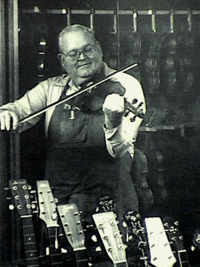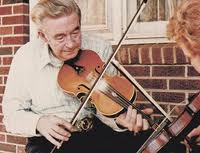Annotation:Hangman's Reel: Difference between revisions
No edit summary |
No edit summary |
||
| (6 intermediate revisions by 2 users not shown) | |||
| Line 1: | Line 1: | ||
---------- | |||
---- | {{TuneAnnotation | ||
|f_tune_annotation_title= https://tunearch.org/wiki/Annotation:Hangman's_Reel > | |||
'''HANGMAN'S REEL [1]'''. | |f_annotation='''HANGMAN'S REEL [1]'''. American, Reel (cut time). USA, southwestern Va. A Major. AEae or AEac# tunings (fiddle). AABB: ABCD (Silberberg): AABCCDD (Songer): AABBCCDD (Kuntz): AABBCC'DD (Phillips). The origins of the tune are somewhat obscure. It was in the repertoire of Albert Hash, a traditional fiddler of Whitetop or Rugby, Va. and identified by him as originally a British Isles tune, though stylistically that provenance is doubtful. Susan Songer and Clyde Curley (1997) report that New York fiddler Judy Hyman (of the Horseflies) believes it originally derived from the Québecois tune "[[Reel du pendu]]" ([[Hanged Man's Reel]]) and that it was rendered in a Southern old-time style by younger upstate New York fiddlers. According to Hash's nephew, Albert learned "Hangman's Reel" (and "[[Old Sport (2)]]") from a 1968 recording by Texas fiddler Bill Northcutt (1935-1992), still remembered as a top-notch musician. Whether the tune was a Southern traditional tune or a "revival" processing, it has since become a very popular "festival tune" among younger old-time fiddlers and frequently heard at square dances. See the related melody "[[Rattlesnake]]." [[File:northcutt.gif|200px|thumb|right|Bill Northcutt]][[File:hash.jpg|200px|thumb|left|Albert Hash]] | ||
|f_source_for_notated_version=Albert Hash via Liz Slade (Yorktown, New York) [Kuntz]; Tim O'Brien [Phillips]. | |||
|f_printed_sources=Phillips ('''Traditional American Fiddle Tunes'''), vol. 1, 1994; p. 108. Silberberg ('''Tunes I Learned at Tractor Tavern'''), 2002; p. 58 (appears as "Hanged Man's Reel"). Songer ('''Portland Collection'''), 1997; p. 92. | |||
|f_recorded_sources=County CO-CD-2711, Kirk Sutphin - "Old Roots and New Branches" (1994). June Appal 014, John McCutcheon - "The Wind That Shakes the Barley" (1977. Learned from Albert Hash). Marimac 9040, The Heartbeats - "Living in Black and White" (1990). Stoneway STY 103; Bill Northcutt, Bill Clemmons, Doc Hamilton - "Old Time Hoedown" (1968). | |||
|f_see_also_listing=Jane Keefer's Folk Music Index: An Index to Recorded Sources [http://www.ibiblio.org/keefer/h01.htm#Hanre]<br> | |||
Hear Albert Hash's recording at Slippery Hill [https://www.slippery-hill.com/content/hangmans-reel]<br> | |||
}} | |||
------------- | |||
Jane Keefer's Folk Music Index: An Index to Recorded Sources [http://www.ibiblio.org/keefer/h01.htm#Hanre]<br> | |||
<br> | |||
---- | |||
Latest revision as of 20:48, 1 November 2021
X:1 T:Hangman's Reel N:From the playing of fiddler Albert Hash (1917-1982). Hash was N:born in Rugby, Va., and grew up in Grayson County, southwest Virginia He learned N:to play from Corbit Stamper, Jim Reedy, his uncle George Finley, and was influenced N:by G.B. Grayson. After Grayson was killed, Albert played with Henry Whitter, among N:others, including his Whitetop Mountain Band in the 1940's. In the 1970's he formed N:a reconstituted Whitetop Mountain Band with his brother-in-law Thornton Spencer N:and Spencer's wife, Emily. M:C| L:1/8 R:Reel N:AEae tuning (fiddle) D:Whitetop Heritage (Galax) LP 041 D:https://www.slippery-hill.com/content/hangmans-reel Z:Transcribed by Andrew Kuntz K:A ((3[EA]-[FA]-[GA]-|:[A2A2])[AA][AA] [AB][AA][AB][AA]|[Ac][AA][Ac][AA] BAFE|[A2A2][AA][AA] [AB][AA][AB][AA]|[Ac][AA][Ac][AA] B2EE| [A2A2][AA][AA] [AB][AA][AB][AA]|[Ac][AA][Ac][AA] BcAB|cAcA BABA|1A2 [AA][AA] [A2A2][AA][AA]:|2[AA][AA] [A2A2][AA]c|| [e2e2][ee][ee] [e2e2][ee][ee]|eAcA B-AAc|ecAc ecAB|cABc A2Ac| [ee][ee]cA [ee][ee][ee][ee]|cABA BAAc|ecAc ecAB|cABc A2AA|| A-BBB B2B2|ABcA BAFE|JB2 BA B2BA|AFED CB,A,A-| B2BA B2 BA|ABcA BAFA|B2 BA B2BA|AFED CB,A,2|| |:CA,CA, DFED|CA,CA, DFED|CA,CA, DFED|CB,A,C B,A,B,A,| CA,CA, DFED|CA,CA, DFAB|cAcA BABA|A2 AA A2EE:|



